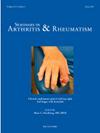Two clinical subgroups of immune checkpoint inhibitor-induced inflammatory arthritis determined by latent class analysis
IF 4.4
2区 医学
Q1 RHEUMATOLOGY
引用次数: 0
Abstract
Background
Immune checkpoint inhibitors (ICI) for cancer treatment can cause inflammatory arthritis (IA). Since ICI-IA has a unique pathogenesis, applying categories of traditional IA may be of limited use.
Methods
Participants were ≥18 years old, treated with anti-PD-1, anti-PD-L1, and/or anti-CTLA-4 agents, and had ICI-IA diagnosed by a rheumatologist. We clustered patients using latent class analysis (LCA) applied with phenotypic data from the baseline rheumatology visit. The Bayesian Information Criteria (BIC) was used to select the number of phenotypes. We compared demographics, cancer type and treatments, and IA clinical features and treatments between the estimated phenotypes. Finally, we explored differences in cytokine levels and the presence of shared epitope between the groups.
Results
Twenty variables were used to estimate latent classes. Two distinct phenotypes were indicated by the BIC; 77 patients were estimated to be the first phenotype and 49 in the second phenotype. The statistically significant features that distinguished the phenotypes included higher levels of all components of the CDAI, more stiffness, and more small and upper extremity joint involvement for phenotype 2. Patients in phenotype 2 were marginally more likely to require steroids during their course. There were no significant differences in cancer type, stage or ICI treatment between the phenotype groups. Baseline levels of VEGF-A were higher in phenotype 2.
Conclusions
Two separate phenotypes of ICI-IA were identified using LCA, the second having a more severe polyarthritis at baseline and involving the upper extremities. These subgroups provide an opportunity to identify corresponding biomarkers to predict disease outcomes.
通过潜在分类分析确定免疫检查点抑制剂诱导的炎性关节炎的两个临床亚组
用于癌症治疗的免疫检查点抑制剂(ICI)可引起炎症性关节炎(IA)。由于ICI-IA具有独特的发病机制,应用传统的IA分类可能用处有限。方法参与者年龄≥18岁,接受抗pd -1、抗pd - l1和/或抗ctla -4药物治疗,风湿病学家诊断为ICI-IA。我们使用潜在分类分析(LCA)结合基线风湿病学访问的表型数据对患者进行聚类。采用贝叶斯信息准则(BIC)选择表型数量。我们比较了人口统计学、癌症类型和治疗,以及估计表型之间的IA临床特征和治疗。最后,我们探讨了细胞因子水平的差异和两组之间共享表位的存在。结果用20个变量估计潜在分类。BIC显示了两种不同的表型;77例患者为第一表现型,49例为第二表现型。区分表型的统计学显著特征包括更高水平的CDAI所有成分,更僵硬,以及表型2更多的小肢和上肢关节受累。表型2型患者在治疗过程中更可能需要类固醇。表型组之间在癌症类型、分期或ICI治疗方面无显著差异。表型2中VEGF-A的基线水平较高。结论使用LCA鉴定出两种不同的ICI-IA表型,第二种在基线时具有更严重的多关节炎并累及上肢。这些亚组提供了鉴定相应的生物标志物来预测疾病结果的机会。
本文章由计算机程序翻译,如有差异,请以英文原文为准。
求助全文
约1分钟内获得全文
求助全文
来源期刊
CiteScore
9.20
自引率
4.00%
发文量
176
审稿时长
46 days
期刊介绍:
Seminars in Arthritis and Rheumatism provides access to the highest-quality clinical, therapeutic and translational research about arthritis, rheumatology and musculoskeletal disorders that affect the joints and connective tissue. Each bimonthly issue includes articles giving you the latest diagnostic criteria, consensus statements, systematic reviews and meta-analyses as well as clinical and translational research studies. Read this journal for the latest groundbreaking research and to gain insights from scientists and clinicians on the management and treatment of musculoskeletal and autoimmune rheumatologic diseases. The journal is of interest to rheumatologists, orthopedic surgeons, internal medicine physicians, immunologists and specialists in bone and mineral metabolism.

 求助内容:
求助内容: 应助结果提醒方式:
应助结果提醒方式:


